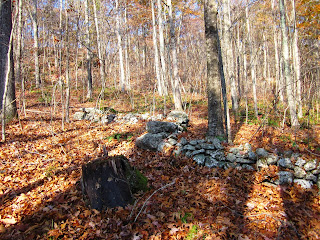The proper term is "Rhomboidal," as Dr. Luci Lavin suggested to me (via an email), noting that the shape often occurs in other forms of Indigenous Artwork, such as ceramic pottery.
The Mohegan Tribal Museum has a rhomboidal stone incorporated into the (stone) chimney on the (stone) building and is referred to as the "Mohegan Healing Diamond."
A second trip into Grey Fox Woods eventually led me to this very beautiful, and very carefully constructed, zigzag stone row. I can't quite find it on any old aerial photo or modern bing or google view quite yet, the cognitive map isn't in focus quite yet (and the modern photos from the sky too old to include the latest road added into the area).
But it stuck me as quite beautiful and I first headed up hill, to the west, to see what it might connect to...
And it sort of got smaller and lower and fainter until I wasn't even sure it was there anymore...
...and there along the sight line of this was a little cliff top outcrop:
Now there's a shape you don't see often - a rhombus:
I was reminded of a Ridge Top for a moment, about a half mile (west) away from here that is edged with a boulder and large cobble row like this: http://wakinguponturtleisland.blogspot.com/2012/09/ridgetop.html
and of another stone of this shape somewhere.
Then I read, early this morning, my friend Peter's post about the passing of his father and his walk into the woods behind his former home. I hope the beauty of the Ceremonial Site there in those sweet woods was a comfort to him, walking paths he taken with his father, past Memorial Piles of Stones, perhaps many made by sons in honor of their fathers...
Had I been showing my friend around (I can't go there without thinking about him), I would have headed a little north and west (although I see I mistakenly said SE in a blog post) to show him this rather massive boulder construction:
I guess I once described it as "a split filled pedestaled boulder with standing stone" here:
The other side looks nothing like a rhombus:
There's a lot of splitting and filling and artistic placement going on in this stone construction - including the little flat a level "table" sort of boulder beside it:
(The Gages have this to say about the shape:
"DIAMOND"
Description: A double-ended triangle. Only three examples so far have been found. One is white quartz stone at Gungywamp, second is a tall slab at America’s Stonehenge and third is a purple shadow on a standing stone in Salisbury, MA.
Usage: Protective symbolism; possibly other
Usage: Protective symbolism; possibly other
A side view of the Rhombus at Grey Fox:
I did climb up to look out toward the East, over the beautiful row, and saw a large vista of the distant landscape, perhaps in the past more clear of trees, but didn't take a photo. I don't really know why not...
Instead I walked back down along the Zigzag:
Looking for possible effigies, like perhaps a bear:
Maybe a deer:
Looking at the "point stones:"
Wondering, "Is that a Turtle?"
Marveling about the careful and lasting construction - glimpsing the out crop through the trees:
Looking for cup-like depressions where a person might place a clam shell of tobacco:
Wondering why there would be a gap in the row:
Wondering why it would turn into a linear row:
Turning back to wonder if that big stone at the gap might be a Serpent's Head:
And why not both sides?
Another Turtle?
White Quartz and maybe more of the Rhombus?
Another Tobacco Place?
A Fire Starter Base?
Something Anthropomorphic about it when viewed from the side?
Turning linear:
Looking back west:
The abrupt end at the top of the rise:
(Possibly a Great Serpent with an "Open Mouth" or even an "Egg in Mouth?")
The end stone of the Beautiful Stone Row:




































The proper term is "Rhomboidal," as Dr. Luci Lavin suggested to me, noting that the shape often occurs in other forms of Indigenous Artwork, such as ceramic pottery. The Mohegan Tribal Museum has a rhomboidal stone incorporated into the chimney on the building and is reffered to as the "Mohegan Healing Diamond."
ReplyDeleteThe "zig zag" is a constellation- we call it today, based on Greek mythology, Cassiopeia- but it is known in Algonquian lore (Algic lang. family) as the serpent- shows up in ME as a petroglyph likely associated with Woodland pd. planting/maize horticulture (per M. Heddon). I suspect same/similar association- putting it in same time period as the stone calendar building- the constellation's position in the sky was considered to have important chronometric associations-
ReplyDeleteAnd looking at the over head and your enhancement of the serpent, it strikes me that the image is not a single serpent, but is meant to represent the serpent moving - there almost seem to be several "heads" along the course. I wonder if the whole isn't actually some type calendar variant- the different segments representing the passage of specific lengths of time of some type of key cycle? Hard to say without being on the ground, and viewing it at different times of year, different times or day .
ReplyDeleteThere are a few more posts about this "Grey Fox Serpent." It may "shimmer" in firelight or moonlight...
Delete"Grey Fox Serpent
ReplyDeleteImagining Firelight
And Moonlight
Dancing on Stone Serpent Scales..."
https://wakinguponturtleisland.blogspot.com/2017/04/grey-fox-serpent.html